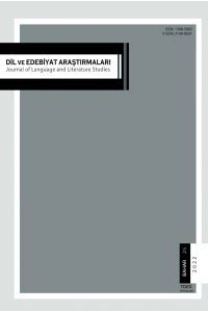İnsan Nesne İlişkilerini Ömer Seyfettin Hikâyelerinden Okumak
Zihniyet değişimi, insan nesne ilişkilerindeki değişim üzerinden izlenebilir. Ahmet Güner Sayar’ın Lamartin’den aktardığı; “Bu ulus gerçekten hiçbir şey yaratmıyor, hiçbir şeyi yenilemiyor. Fakat hiçbir şeyi kırıp tahrip de etmiyor,” ifadesi Türk’ün eşya ile ilişkisini özetler niteliktedir. Ömer Seyfettin, Ziya Gökalp, Yusuf Akçura gibi isimlerce ticarete mesafeli olduğu dile getirilen Türk insanının mesafesinin sebebi olarak nesneye bakışı gösterilir. Tanzimat ile başlayan değişim, II. Meşrutiyet itibariyle insan nesne ilişkilerinde farklı bir boyut kazanmıştır. Bu dönemde nesneye bakışta geleneğin belirlediği sınırların dışına çıkılmıştır. İdeologlar, hiçbir şeyi yenilemediği söylenen ulusu, her şeyi toptan yenilemek için yeni hayat idealiyle örgütlenmek istemişlerdir. Yenileşme idealine savaş koşulları da eklenince toplumsal hayatta pek çok şeyin kırılıp tahrip olması da kaçınılmaz olmuştur. Dolayısıyla II. Meşrutiyet sonrasına hem yenileşmenin hem tahribin bir arada yaşandığı bir değişim dönemi denebilir. Bu değişimi en iyi gözlemleyebildiğimiz metinlerin başında da Ömer Seyfettin’in hikâyeleri gelir. Bu bağlamda makalemizde Ömer Seyfettin hikâyelerinde insan nesne ilişkilerine bakışı ele alacağız.
Reading The Human-Object Relationship Through The Short Stories Of Ömer Seyfettin
The transformation of the mindset can be tracked through the transformation of the human-object relationship. Lamartine’s statement, quoted by Ahmet Güner Sayar, “This nation does not actually create anything and renew anything. It does not destroy anything, either” can be considered as the essence of Turkish people’s relationship with the object. The reason for the distance of Turkish people, who were said to be distant to trade by authors such as Ömer Seyfettin, Ziya Gökalp Yusuf Akçura, is shown to be the way they view the object. The transformation which started with the Declaration of the Tanzimat Edict caused the human-object relationship to gain a different aspect in the second constitutional period. In this period, the way the object is viewed went beyond the boundaries determined by tradition. Ideologists wanted to organize the nation, which is said to renew nothing, with the ideal of a “new life” in order to renew everything altogether. When war conditions were added to the ideal of innovation, it became inevitable that many things in social life would be broken and destroyed. Hence, the post-second constitutional period can be called a period of transformation in which both innovation and destruction occurred together. Ömer Seyfettin’s short stories, in this vein, are the primary texts through which we can observe this transformation. In this context, this article will focus on how the human-object relationship is perceived in the short stories of Ömer Seyfettin.
___
- Akçura, Yusuf, Siyaset ve İktisat, Ötüken Yayınları, İstanbul, 2016
- Barthes, Roland, Göstergebilimsel Serüven, Çev. Mehmet Rıfat, Sema Rıfat, Yapı Kredi Yayınları, İstanbul, 2012
- Baudrillard, Jean, Gösterge Ekonomi Politiği Hakkında Bir Eleştiri, Boğaziçi Üniversitesi Yayınları, İstanbul, 2009
- Gökalp, Ziya, Yeni Mecmua Yazıları, Haz. Dr. Salim Çonoğlu, Ötüken Yayınları, İstanbul, 2018
- Ömer Seyfettin, Bütün Hikâyeleri, Haz. Nazım Hikmet Polat, Yapı Kredi Yayınları, İstanbul, 2011
- Sayar, Ahmet Güner, Osmanlı İktisat Düşüncesinin Çağdaşlaşması, Ötüken Yayınları, İstanbul 2013
- Tabakoğlu, Ahmet, İslam İktisadı Toplu Makaleler II, Kitabevi, İstanbul, 2005
- Toprak, Zafer, Milli İktisat- Milli Burjuvazi, Tarih Vakfı Yurt Yayınları, İstanbul,1995
- Toprak, Zafer, Türkiye’de Yeni Hayat İnkılap ve Travma 1908-1928, Doğan Kitap, İstanbul, 2017
- Uçar, Aslı, Teselliyi Eşyada Aramak: Türkçe Romanda Nesneler, İhsan Doğramacı Bilkent Üniversitesi, Türk Edebiyatı Bölümü, Ankara, 2012
- Ülgener Sabri, İktisadi Çözülmenin Ahlak ve Zihniyet Dünyası, Derin Yayınları, İstanbul, 2006
- ISSN: 1308-5069
- Yayın Aralığı: Yılda 2 Sayı
- Başlangıç: 2010
- Yayıncı: TÜRKİYE DİL VE EDEBİYAT DERNEĞİ
Sayıdaki Diğer Makaleler
Göç ve Edebiyat: Londra’nın Türk Göçmenleri
Bağlama Kuramı ve Türkçedeki Kendisi Artgönderimsel İfadesine Yakından Bakış
Düşsel ve Romantik: Keats’in “Lamia”sında Türsel Çeşitlilik
XIX. Yüzyıl Başları Üsküdar’ında Ekonomik ve Toplumsal Bir Güç Olarak Yeniçeriler
Eski Köye Yeni Roman’ın Konumu/Alımlanışı, Niyeti ve Anlatı Stratejisi
Bilinmeyen Bir El Yazması Seyahatnâme: Kâtip Fâik’in “Almanya Seyahatnâmesi”
Migration and Literature: London’s Turkish Immigrants
Müzik-Edebiyat İlişkisinin Metinlerarası Yorumları: Aşk-ı Muhabbet Sevda
